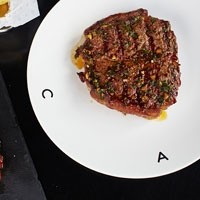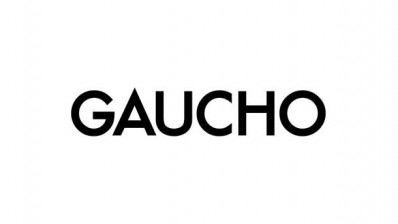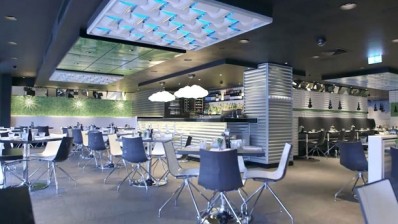Business Profile: CAU

CAU has taken a somewhat unusual route to the UK high street. Born in Argentina – conceptually-speaking, at least – the steak-focused format launched near Amsterdam’s tourist-packed Damn Square in 2010 and arrived on these shores a year or so later with the opening of a branch in Guildford, Surrey.
CAU (it stands for Carne Argentina Unica, if you were wondering) is little brother to Gaucho, the country’s biggest premium steak player with 15 UK sites. The London-centric group is among the most respected in the space with industry-leading staff training and high-quality, freshly-made food. As such it’s one of the few restaurant chains to command high spends with people happy to drop serious cash on its expertly grilled Argentine steaks and malbec-heavy wine list.
Owned by the same holding company, CAU was conceived by Gaucho’s Dutch founder Zeev Godik as a smaller, more affordable version of Gaucho that could bring high-quality steak to the masses by setting up shop in smaller cities and towns. The look is brighter and more overtly branded than most Gauchos with shiny white PVC banquettes, equally lustrous fixtures, grass wallpaper and ceilings painted to resemble the sky.
While it’s perhaps a few sets of hooves short of a stampede, this cow-focused restaurant group is now expanding across the south of England at a solid pace and will soon head northwards. The past 12 months have seen the estate double in size with branches in Cambridge, Blackheath, Tunbridge Wells and Kingston-upon-Thames. Plans are in place to open a further three locations this year – in Bristol, Wimbledon Village and Henley-on-Thames – which will bring it up to nine sites.
CAU’s growth plan might lack the aggression of Bill’s or Côte, but it’s shaping up to be a well-executed rollout nonetheless and the group looks likely to becoming the first truly national premium steak purveyor. Moreover its expansion is being overseen by operations director Graham Hall, a relative newcomer to the business having joined in May last year.
Operations directors usually work under an overall MD but there are no plans to recruit above Hall. As such, he is the key person behind the brand, supported by finance director Gary Mann and design director Patsy Godik, who both hold the same roles within Gaucho.
Despite sharing some staff with its older sibling, Hall is keen to ensure that CAU is seen as a group in its own right. “We do share some functions such as payroll and purchasing and I speak to Tracy [Matthews, Gaucho’s managing director] all the time, but we’re a separate entity,” he says. “We’d be silly not to draw from some of Gaucho’s brilliant culture as it’s obviously highly relevant to what we do, but it’s important that we build our own identity too.”
Hall’s route into the upper echelons of the restaurant industry was typical in the sense that he started out doing something entirely unrelated to hospitality – a degree in mechanical engineering and design at Nottingham. Hall pulled pints to support his studies and as his course came to an end he decided he’d be more fulfilled working in bars and restaurants than within engineering blue chips. He took a job with respected north-west operator Living Ventures and kept his senior ops role within the Living Room Group when it split from the Tim Bacon-led company. Some years later, he headed southwards to become ops manager at London’s All Star Lanes group.
Now in his mid-30s, Hall is not short of front line operational experience but admits he’s still got some way to go on the property side, with overall Gaucho Holdings’ boss Godik helping out with site selection. Flanked by the new wave of quality casual branded competition – Bill’s, Côte, Comptoir Libanais and Busaba Eathai – CAU’s most recent restaurant at Kingston-upon-Thames’s new Riverside development is
a good example of the group’s strategy.
“We’re looking at affluent suburbs and towns with a bit of buzz about them,” says Hall. “We want locations with good footfall but we’re not scared about being at the end of the high street or slightly off it – we’re not too precious. Godik and I are obviously looking at where the really fast expanding guys are going, too.”
New locations
On a rather uninspiring Wednesday lunchtime, it looks like these players may have chosen the wrong location. CAU is certainly not losing out to its competition – 12 diners are sitting, rather bravely, outside under sun parasols that will shortly double up as umbrellas – but punters at this new Kingston development are thin on the ground. Hall is confident it’s the right spot for his brand, however, and says the restaurant is busy in the evenings while the terrace – which offers enviable views of leafy Hampton Wick – is mobbed on sunny days.
In general CAU takes comparatively small sites of a little over 100 covers, in contrast to Gaucho, which operates some of the biggest restaurants in London. The forthcoming Bristol opening, in the city’s well-heeled Clifton Triangle, will, however, become the group’s largest site at 150 covers (the site in Amsterdam, a former Gaucho, is a huge, three-floor affair).
Next year Hall’s focus will shift to his old stomping ground, the north-west. “I know the area well and I’m looking forward to building CAU’s presence there. It’s not a place to be scared of, as a lot of smaller groups are. You don’t need to grow to 40 restaurants before you turn your attention to places such as Chester and Liverpool.” Hall is also looking to bring the brand to Manchester and Leeds, the northern cities where Gaucho already has a presence.
Hall has not ruled out a central London opening but believes the regions currently provide more than enough opportunities. “Ten years ago it was hard to get a good steak in London,” he says. “Now we have Gaucho, of course, as well as lots of great small groups and independents. Other cities and towns want great steak too so that’s what we’re going to do first. I think we will do London at some point but there’s no rush.”
Price points
The group is primed for speedy expansion with dedicated opening training teams for kitchen, bar and floor moving from branch to branch. Finding staff is proving tricky, however, particularly at locations where lots of other restaurants are opening at the same time. “This site was tough because all the other brands needed good staff too,” says Hall. “Finding 70 ready and willing chefs in such a small area is no easy task.”
CAU runs a similar kitchen set-up to Gaucho with a long cooking line and all food produced fresh on site. “Not producing or getting any products made offsite is one of our key points of difference,” he adds. “It pulls customers in but it also attracts a better calibre of chef. Increasingly, we’re targeting catering college leavers because they come with some training but no bad habits and they’re keen to develop their skills. A lot of my floor staff have no experience – that’s something I picked up from Tim Bacon and the other guys at Living Ventures. If they have a good personality, work hard and are willing to learn it will be fine.”
CAU retains its status as a steak specialist with a cleverly curated selection of Argentine wet-aged beef sourced from the same Pampas-based farmers as its bigger brother.
Cuts that will be familiar to a UK audience like rump, rib-eye and sirloin rub shoulders with traditional Argentine cuts such as lomito and tapa de cuadril (both from the rump) and the tira de ancho, an impressive spiral cut of rib-eye marinated and grilled slowly to promote tenderness. Pricey cuts such as fillets and T-bones are avoided to keep Cau competitive on the high street with most single steaks around the £15 mark.
“It’s challenging running a steak restaurant at this price point but the buying power of Gaucho Holdings helps. Argentine beef is also good value compared with UK beef as the wet-aging process doesn’t result in weight loss – dry-aged steaks lose around 25% of their weight.
“UK-style cuts make up the bulk of sales, as much as 70% at some branches, but we are seeing an increase in people trying the Argentine cuts. I believe they’re superior as they tend to be cut from a single muscle, which means tenderness.”
Like its sibling, all the beef at CAU is butchered in house. This allows offcuts to be used in burgers and smaller steaks to be used in sandwiches, a double win for CAU because it provides a very approachable price point for some menu items while totally eliminating wastage.
Menu overhall
Last year the CAU menu underwent a significant overhaul. The original carte was smaller and had a stronger bias towards steak and other beef dishes than it does today. This was causing issues at lunchtimes – the perception that CAU was purely a steak restaurant was holding back the business and the kitchen’s reliance on expensive beef was also putting a strain on its pricing.
Hall and executive chef James Garland took the cosmopolitan restaurant scene of Buenos Aires as their muse and created a more expansive menu. Crucially, it now ticks off a wide variety of product categories and dishes while staying true to the brand’s Argentine theme. The presence of familiar dishes including fish cakes, steamed mussels, aubergine lasagne and Argentine-style flat bread pizzas opens up CAU to a more mainstream audience and puts it on a more even footing with its branded rivals.
“The menu now reflects what’s going on in Buenos Aires today,” says Hall. “The restaurant scene there is eclectic – we can take our pick from a wide range of cuisines including Italian and Spanish. We’ve also introduced a small plates section and have marginally lowered our prices.”
This new strategy is working, with lunch sales on the rise across the estate and all locations turning over in excess of £30,000 per week. This plucky new entrant has already managed to step out of the shadow of its high-spend stable mate and looks likely to fulfil its ambition of bringing Argentine food to a national audience.



































